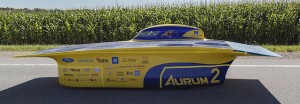Analytics
Chasing the Sun with Cognitive Technology
October 1, 2015 | Written by: Steve Hamm
Categorized: Analytics | Big Data | Cognitive Computing | IBM Research | Smarter Planet
Share this post:
By Steve Hamm
IBM Chief Storyteller
In the solar energy realm, nothing beats the drama and fun of the biennial Bridgestone World Solar Challenge, an 1800-mile race in solar-powered cars across the Australian outback. Teams from dozens of universities around the world compete for global bragging rights–combining precision teamwork with advances in software, electronics, materials and aerodynamic design.
For this year’s race, which will take place October 18 to 25, there’s an exciting new technology in play: cognitive computing. IBM Research scientists are collaborating with the University of Michigan’s solar car team to provide solar forecasting technology they hope will give the team’s car, Aurum, a decisive edge.
View our full coverage of the technology, the teams and the race here.
In the past, members of Michigan’s team–like all the others–relied on weather reports or stuck their heads out the windows of support cars and stared at the sky, guessing at the size and motion of clouds, and instructing their drivers to speed up or slow down to avoid spending too much time in the shade. The practice is commonly called “cloud chasing,” though “sun chasing” might be more apt.
Now, thanks to the work of IBM Research scientists, the University of Michigan team will have real-time forecasts telling them how to avoid clouds and longer-term forecasts that will help them make strategic decisions about how fast to go and when to stop to take advantage of the best recharging conditions. Counter intuitively, the Michigan team is actually hoping for rain during the last days of the race–figuring that they alone will have seen it coming in super-accurate detail and planned for it.
“We think this could be a critical factor in helping us finish the race first,” says Leda Daehler, Strategy lead, University of Michigan Solar Car.
For IBM, the collaboration with the Michigan students is about more than just a solar car race. If our technology gives the team an edge, it will showcase the advantages that organizations of all types can gain from using cognitive technologies. Best known for their association with IBM’s Watson, cognitive systems ingest vast quantities of information, understand it, learn from their interactions with data and humans, and interact with people in ways that are more natural to us.
Says Dario Gil, Vice President for Science & Technology at IBM Research: “Our role in this race represents IBM’s commitment to creating technologies that can help individuals and organizations make better decisions–leading to running a business in a way that can transform industries.”
In fact, IBM’s solar forecasting technology was developed originally for the electric utility industry. These days, utility companies, energy producers or consumers are aggressively adding alternative energy sources to their systems, including solar and wind power. The problem is, solar and wind are intermittent and energy can’t be stored at scale, so the utilities have to quickly change their supply mix when the wind shifts suddenly or the sun doesn’t shine. It’s a major headache. But accurately predicting the availability of solar and wind energy makes managing the grid much easier.
It’s also critical, potentially, to the future of the planet. Being able to satisfy ever-larger slices of our energy needs with renewables will help us forestall the worst effects of climate change.
Through our work with the US Department of Energy’s SunShot initiative, and, in collaboration with ISO-New England, a regional grid operator and other industrial partners, we have shown that our forecasting system can be 30 percent more accurate than other state-of-the-art approaches.
The forecast technology uses a combination of machine learning, big data analytics and mathematical modeling of complex weather systems. The system continuously monitors weather conditions and analyzes that data to forecast how much solar energy will be available at different locations and times.
One of the differentiating features of the IBM approach is that we incorporate a large number of weather and solar energy prediction models, which we blend to create a supermodel. Our “secret sauce” is the way we learn how to categorize different weather and climate situations so we can predict when various weather models may fail under certain circumstances. That helps us pick an optimal combination of weather models for particular locations.
The new dimension we added for the solar race was our real-time monitoring of weather conditions just ahead of the race car. We added GPS to the solar cameras we developed for the DOE and attached them to the top of a scout car that travels about 30 minutes ahead of Aurum. We capture information about the type, size, speed and direction of the clouds and combine it with weather modeling data and information about the location and speed of the racer, the battery charge levels, and other factors.
We mash together all this data, send it by satellite uplink to our computer system in the United States, analyze it, and send up-to-the minute advice to Michigan’s race leaders. They make decisions and radio instructions to the driver.
During one of the mock races that the Michigan team conducted this summer, our forecasts for one and two days ahead diverged from those produced by one of the dominant weather models. And it turned out that ours were more accurate. That told our scientists–and the Michigan team–that our technology could indeed make a difference for them. “This is the kind of experience that convinces you that all your hard work is worthwhile,” says Siyuan Lu, one of the IBM Research scientists responsible for developing the solar forecasting technology.
Meet the Newest IBM Fellows
Since the first class of IBM Fellows in 1962, IBM has honored its top scientists, engineers and programmers, who are chosen for this distinction by the CEO. Among the best and brightest of IBM’s global workforce are 12 new IBM Fellows who join 293 of their peers who have been so recognized over the last […]
How IBM is Advancing AI Once Again & Why it Matters to Your Business
There have been several seminal moments in the recent history of AI. In the mid-1990s, IBM created the Deep Blue system that played and beat world chess champion, Garry Kasparov in a live tournament. In 2011, we unveiled Watson, a natural language question and answering system, and put it on the hit television quiz show, […]
Watson Anywhere: The Future
(Part 3 in a Series) There’s a paradox in the world of AI: While it’s the largest economic opportunity of our lifetime (estimated to contribute $16 trillion to GDP by 2030), enterprise adoption of AI was less than 4% in 2018. A recent Gartner survey said that the 4% in 2018 has now grown to […]




